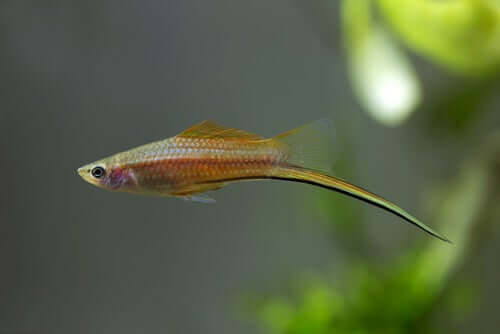Swordtail Fish - Diet and Reproduction


Written and verified by the biotechnologist Alejandro Rodríguez
If we say Xiphophorus, you probably won’t know we’re talking about. But we’re sure you might know them by one of their more common names: swordtail fish, platyfish, and platy. This is one of the most common fish in aquariums. Read this article and learn more about its characteristics, diet, and reproduction.
What’s a swordtail fish?
The first thing to know about this fish is that it belongs to a very special order: the Cyprinodontiformes. This is a well-known group of fish since it encompasses several highly-prized species for aquarium farming.
Within the Cyprinodontiformes, there’s a family of freshwater fish with a series of very specific features. Those characteristics include their wide geographical distribution. Also, the size of their eyes or their marked sexual dimorphism. They belong to the Poeciliidae family which has up to 40 different genera.
There are some very well-known species in this group of fish, such as Gambusia holbrooki or the guppy (Poecilia reticulata).
The one we’ll be dealing with in this article is the Xiphophorus. This genus encompasses 28 described species, and the swordtail fish (Xiphophorus hellerii) is one of them. This fish is also known as the green swordtail.
General characteristics

The average size of the swordtail varies between 5 and 6 inches. They have a robust and elongated body, which, in males, ends in the most intriguing tail fin. The radius of the lower part of the fin is elongated. So, it kind of looks like the tail has a sword in it.
There’s an additional modification of the fins in males. It’s the one they have in their anal fin. This modification changes into an organ used for intercourse. It’s called the gonopodium. The females are larger, despite lacking the “sword.” There are also differences in the coloration between males and females, which is a form of sexual dimorphism.
The color of the swordtail fish varies between wild and domestic specimens, even though wild fish have a greenish pattern with some slightly yellow stripes. The specimens for aquarium breeding have a wide variety of colors, from black to red.
Food and behavior
This is an omnivorous fish whose diet includes small invertebrates, algae, and other plant debris. However, they only find this type of food when living in the wild. If you have a specimen at home, then a balanced commercial diet will suffice. Note that it must contain dry material and live food such as mosquito larvae and plankton.
Normally, the swordtail fish is a rather peaceful animal. They tend to ignore the rest of their aquarium companions, as long as they’re the same size. However, the temperament of males can become violent due to territorial disputes, and for reproductive reasons. So, if you plan to have swordtail fish at home, the ideal situation would be for a single male to live with several females.
Swordtail fish reproduction

All the Poeciliidae are livebearers, which implies that the females keep the eggs inside them until they give birth. This makes the fry larger than those who are oviparous. Therefore, they can swim freely without needing too much protection from their parents.
Fertilization occurs when the male fertilizes the female through the gonopodium. So, after a period of four to six weeks, the fry will come out. From that moment, you must pay attention to the aquarium, since it’s very common for swordtail to chase their young and try to eat them.
If you’re careful and patient, after approximately one year you’ll have some wonderful adult specimens of Xiphophorus in your fish tank.
All cited sources were thoroughly reviewed by our team to ensure their quality, reliability, currency, and validity. The bibliography of this article was considered reliable and of academic or scientific accuracy.
- Basolo, A. L., & Wagner Jr, W. E. (2004). Covariation between predation risk, body size and fin elaboration in the green swordtail, Xiphophorus helleri. Biological Journal of the Linnean Society, 83(1), 87-100.
- Earley, R. L., & Dugatkin, L. A. (2002). Eavesdropping on visual cues in green swordtail (Xiphophorus helleri) fights: a case for networking. Proceedings of the Royal Society of London. Series B: Biological Sciences, 269(1494), 943-952.
This text is provided for informational purposes only and does not replace consultation with a professional. If in doubt, consult your specialist.